|
Natalie's office
Although the exterior of the Coroner's Building was filmed on location, for Natalie's office, a set was built at the studio. Because of the way it is filmed (the angles and lenses used), one gets the impression that the room is a fair size; but, actually, it was quite a small set, though a full four-sided one. It is an all-purpose room, tiled in turquoise, that combines the functions of office, lab, and autopsy room.
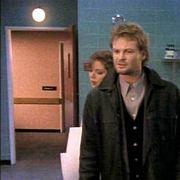
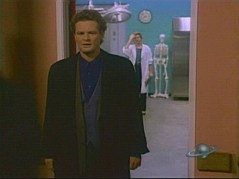 In the first season of Forever Knight, there was no hallway built outside the main door into Natalie's office. In the second season, however, the set was extended to include a portion of the hall outside. It is painted in an orangy salmon shade, with small eye-level labels indicating what the rooms are for, and a band of wood trim lower down. Only a small part of the hall was seen, basically just through Natalie's open door.
In the first season of Forever Knight, there was no hallway built outside the main door into Natalie's office. In the second season, however, the set was extended to include a portion of the hall outside. It is painted in an orangy salmon shade, with small eye-level labels indicating what the rooms are for, and a band of wood trim lower down. Only a small part of the hall was seen, basically just through Natalie's open door.
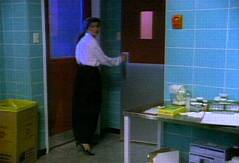 Inside Natalie's office, the door is recessed slightly from the room. The actual depth is just enough for the door to open along the wall; but it is often accentuated by the way it is filmed. There is an emergency light over the door, and a small window set in it. This is the way that bodies are brought in on gurneys for Natalie to autopsy.
Inside Natalie's office, the door is recessed slightly from the room. The actual depth is just enough for the door to open along the wall; but it is often accentuated by the way it is filmed. There is an emergency light over the door, and a small window set in it. This is the way that bodies are brought in on gurneys for Natalie to autopsy.
 At right angles to this door, on the side wall, is a second door into Natalie's office. This has a good-sized window in it; but, although it shows blue, this is presumably the tint of the glass, for the walls beyond are in the same orange-salmon as elsewhere. Where this
At right angles to this door, on the side wall, is a second door into Natalie's office. This has a good-sized window in it; but, although it shows blue, this is presumably the tint of the glass, for the walls beyond are in the same orange-salmon as elsewhere. Where this
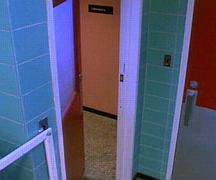 door goes is unclear, given the plethora of entrances to the room; but the visible wall suggests that the door does not open onto a hall running parallel to the side wall of the room, but rather is set into a corner. Perhaps this goes to a staircase, or something like that, for this is the door most commonly used by Nick and his partner when they come to the Coroner's Building to talk to Natalie about something.
door goes is unclear, given the plethora of entrances to the room; but the visible wall suggests that the door does not open onto a hall running parallel to the side wall of the room, but rather is set into a corner. Perhaps this goes to a staircase, or something like that, for this is the door most commonly used by Nick and his partner when they come to the Coroner's Building to talk to Natalie about something.
Logically, the wall visible outside the side door abuts the corridor outside the other door. In the real world, it would be highly unusual to build two corridors parallel to each other on either side of a thin wall. But this is one of the idiocies of set construction. The designers stick entrances all over the place without bothering to consider how they'd fit if the room were part of an actual building.
 Right at the corner of the end wall, by the entrance corridor, there is some equipment kept on a low metal table, perhaps on castors. Just beyond that is a lab bench, with a smooth surface that looks easy to clean. This runs almost to the corner of the room, although there is some equipment fastened up on the wall just beyond its far end. Turn the corner, and you come to a side wall, largely used for hanging things. It runs down to an office area at the far end of the room.
Right at the corner of the end wall, by the entrance corridor, there is some equipment kept on a low metal table, perhaps on castors. Just beyond that is a lab bench, with a smooth surface that looks easy to clean. This runs almost to the corner of the room, although there is some equipment fastened up on the wall just beyond its far end. Turn the corner, and you come to a side wall, largely used for hanging things. It runs down to an office area at the far end of the room.
Above the lab bench, there is a shelf with jars and bottles of chemicals. Fitted under the shelf is fluorescent lighting so that Natalie can see clearly as she works.
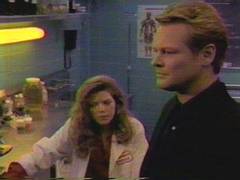
 There is a stool for Natalie to sit on as she works; and various equipment is on
the desk, including a microscope and centrifuge. The body of the bench itself has compartments with what appear to be sliding doors, and shelves on which supplies can be stored. Along the far end of the bench, there seems to be a sink.
There is a stool for Natalie to sit on as she works; and various equipment is on
the desk, including a microscope and centrifuge. The body of the bench itself has compartments with what appear to be sliding doors, and shelves on which supplies can be stored. Along the far end of the bench, there seems to be a sink.
|
 Up on the side wall are, in order, posters of human anatomy, a blackboard, and a lighted X-ray panel. And a gurney is pushed up against the wall. Natalie used to have an articulated skeleton standing there; but nowadays she tends to keep it across the room. A bin for hazardous waste has also sometimes been put here.
Up on the side wall are, in order, posters of human anatomy, a blackboard, and a lighted X-ray panel. And a gurney is pushed up against the wall. Natalie used to have an articulated skeleton standing there; but nowadays she tends to keep it across the room. A bin for hazardous waste has also sometimes been put here.
|

|

|
|
 Further along, Natalie's desk has been set with one end against the wall, so that it juts out partway across into the room, cutting off an office corner. If Natalie is at her desk, therefore, she has to get up and come round it into the middle of the room in order to circle round back to the lighted panel and view an X-ray.
Further along, Natalie's desk has been set with one end against the wall, so that it juts out partway across into the room, cutting off an office corner. If Natalie is at her desk, therefore, she has to get up and come round it into the middle of the room in order to circle round back to the lighted panel and view an X-ray.
When Natalie is at her desk, Nick often stands in front of it, in the space between the desk and the lab bench, having come in the side entrance door and cut across the room in order to talk to her.
This affords him room to pace a bit as he talks to her.
|
|
 If we continue along the side wall (but now within the office area), Natalie has a calendar hanging up; and then there are two cork boards on the wall. This brings us to the corner with the rear wall. Here, butted into the corner and running along the rear wall behind the desk, are a pair of filing cabinets. Natalie keeps all kinds of things on top of them. Next to them is a computer desk, with a PC and a printer.
If we continue along the side wall (but now within the office area), Natalie has a calendar hanging up; and then there are two cork boards on the wall. This brings us to the corner with the rear wall. Here, butted into the corner and running along the rear wall behind the desk, are a pair of filing cabinets. Natalie keeps all kinds of things on top of them. Next to them is a computer desk, with a PC and a printer.



 Natalie's desk is pretty utilitarian: presumably the Coroner's Office puts its money into the medical equipment rather than the office supplies. She does, however, have a desk lamp, some books, a well filled pencil holder, and a phone/intercom on the desk. And it is in this drawer that Natalie keeps the notebook in which she has made a record of the observations and experiments she has done on Nick.
Natalie's desk is pretty utilitarian: presumably the Coroner's Office puts its money into the medical equipment rather than the office supplies. She does, however, have a desk lamp, some books, a well filled pencil holder, and a phone/intercom on the desk. And it is in this drawer that Natalie keeps the notebook in which she has made a record of the observations and experiments she has done on Nick.
|
 Along the rear wall from the computer table, there is a heavy metal
door leading into a refrigerated room, where corpses are kept at a low temperature to preserve
Along the rear wall from the computer table, there is a heavy metal
door leading into a refrigerated room, where corpses are kept at a low temperature to preserve
 them. Continuing along the back wall beyond this door, there is
a tall metal refrigerator. Although we rarely actually see Natalie use it, a sign inside
the door indicates that it is designated to be employed for the storage of blood and tissue
them. Continuing along the back wall beyond this door, there is
a tall metal refrigerator. Although we rarely actually see Natalie use it, a sign inside
the door indicates that it is designated to be employed for the storage of blood and tissue  samples. There is a space under the wall clock between this refrigerator and the door to the cold storage room. When she first worked at the Coroner's Building (i.e. in the first season), Natalie kept a coat rack here for her white lab coats; but nowadays she keeps the
samples. There is a space under the wall clock between this refrigerator and the door to the cold storage room. When she first worked at the Coroner's Building (i.e. in the first season), Natalie kept a coat rack here for her white lab coats; but nowadays she keeps the

 articulated skeleton here, instead. Sometimes she has put here a disposal bin for
contaminated waste, such as blood-stained lab gowns. For a long time, these bins were open-topped, and lined with yellow plastic bags; but these were later replaced with red pedal bins. With the space on one side of the fridge now occupied by the skeleton, Natalie has taken to putting the disposal bin on the other side, in the corner, where there is a gap.
articulated skeleton here, instead. Sometimes she has put here a disposal bin for
contaminated waste, such as blood-stained lab gowns. For a long time, these bins were open-topped, and lined with yellow plastic bags; but these were later replaced with red pedal bins. With the space on one side of the fridge now occupied by the skeleton, Natalie has taken to putting the disposal bin on the other side, in the corner, where there is a gap.
 Turning the corner, you come back to the other side wall.
Turning the corner, you come back to the other side wall.
 Running up from the end corner, there is a second, much longer steel cabinet with several doors. This is another
Running up from the end corner, there is a second, much longer steel cabinet with several doors. This is another
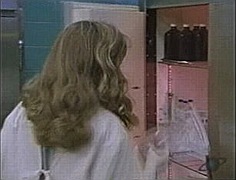 refrigerator. Neither fridge is built in. They clearly stand separate from one another, though in the same general area of the room. They are rarely seen open: indeed, one might almost wonder why Natalie needs so much cold storage, when she so seldom seems to use it.
refrigerator. Neither fridge is built in. They clearly stand separate from one another, though in the same general area of the room. They are rarely seen open: indeed, one might almost wonder why Natalie needs so much cold storage, when she so seldom seems to use it.
 Beyond the long fridge, there is a side door to a corridor,
which, if you turn right as you leave the room, leads to the front door of the Coroner's Building. Nick ran this way in "The Fix", when he went out of the building in daylight to test the effectiveness of the lidovuterine Natalie had injected. Nick and his partner
Beyond the long fridge, there is a side door to a corridor,
which, if you turn right as you leave the room, leads to the front door of the Coroner's Building. Nick ran this way in "The Fix", when he went out of the building in daylight to test the effectiveness of the lidovuterine Natalie had injected. Nick and his partner  sometimes use this door to come into the room; it varies from episode to episode with the vagaries of the different directors.
sometimes use this door to come into the room; it varies from episode to episode with the vagaries of the different directors.
Outside the door, there is a seat up against the wall of the corridor. In "Jane Doe", Natalie talked to Tracy here as she recovered from the ordeal of helping to autopsy a weeks-old corpse.
Just a few feet along this wall is the other side entrance - the one described earlier. Why there should be two doors so close together along the same hall is another of those marvels of set construction that one isn't supposed to think about too much.
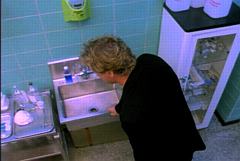 On the short stretch of wall between the two doors, there is a sink handy for cleaning up after an autopsy. The small trolley holding the instruments used for autopsies is often pushed aside to lie against this wall.
On the short stretch of wall between the two doors, there is a sink handy for cleaning up after an autopsy. The small trolley holding the instruments used for autopsies is often pushed aside to lie against this wall.
 There is also a narrow free-standing cabinet with glass windows and bottles inside. Presumably, given the variety of bottles of chemicals elsewhere in the room, the things kept here are ones that require a degree of security, for the cabinet is lockable.
It was in here that Natalie put the lidovuterine in "The Fix" when she decided Nick should stop using it.
There is also a narrow free-standing cabinet with glass windows and bottles inside. Presumably, given the variety of bottles of chemicals elsewhere in the room, the things kept here are ones that require a degree of security, for the cabinet is lockable.
It was in here that Natalie put the lidovuterine in "The Fix" when she decided Nick should stop using it.
At this point we have come all the way round the room, and are back at the side door in the entrance corridor.
 But there is, of course, one more major feature of the room - a large, metal, free-standing autopsy table in the centre. The detectives even get so blasé about their surroundings that they use the autopsy table to lean on, sit on, or put things on - things other than the corpses that it is designed for, that is.
But there is, of course, one more major feature of the room - a large, metal, free-standing autopsy table in the centre. The detectives even get so blasé about their surroundings that they use the autopsy table to lean on, sit on, or put things on - things other than the corpses that it is designed for, that is.
As various angles show, the autopsy table runs parallel to the side
wall, approximately from the blackboard to the end of the desk. Beside
the autopsy table there is a table for instruments; but this is on wheels, so it can be moved if necessary. Natalie does, after
all, sometimes stand on one side of the table and sometimes on the other as she performs an
autopsy, enabling her to get the best possible access to any part of the body on which she is working. And, when she is not examining a corpse, she pushes the little trolley over to the 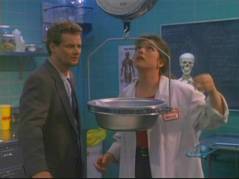 wall by the side door, to keep it out of the way.
wall by the side door, to keep it out of the way.
Above the table is a hanging scale, on which Natalie can weigh  things, such as organs removed during an autopsy. There is also an adjustable lamp, so she can get strong illumination when she needs it - during the close external examination of a body, as well as when she removes sections of the organs for further analysis.
things, such as organs removed during an autopsy. There is also an adjustable lamp, so she can get strong illumination when she needs it - during the close external examination of a body, as well as when she removes sections of the organs for further analysis.
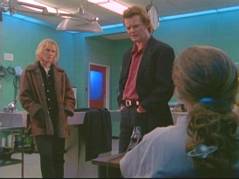 Natalie's desk is only steps away from the autopsy table. But, even though this is a small room, there is sufficient space in the centre to have a group discussion in the area between Natalie's desk and either the autopsy table or the lab bench.
Natalie's desk is only steps away from the autopsy table. But, even though this is a small room, there is sufficient space in the centre to have a group discussion in the area between Natalie's desk and either the autopsy table or the lab bench.
Although the ceiling was not visible in most angles that were filmed, it was white, with long strips of fluorescent lighting.
|